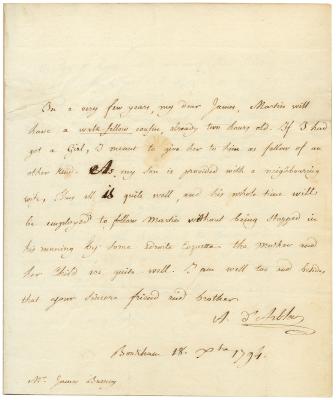As a cataloguer working on the Morgan’s collection of materials related to the eighteenth-century novelist Frances Burney, I’ve come across little-known items which, when examined closely, prove to have unexpected depths.
One of these is a letter from Frances Burney’s husband, Alexandre d’Arblay, a count who fled the French Revolution and met Burney in 1792, when he was staying with a group of French émigrés near the village of Mickleham in Surrey, where Burney’s sister Susanna lived. They married in 1793 and had a deeply affectionate marriage (they called each other “bien meilleur ami” in their correspondence) for twenty-five years, until his death. D’Arblay’s letter, addressed to James Burney, Frances’s brother, looks innocuous enough – it is barely a page long in d’Arblay’s neat hand. Before the cataloging project currently underway, it did not have an individual catalog record; it was acquired with the other Burney materials in 1905, all of which were described in general terms in a single record. But it contains momentous news, written on the day of its occurrence: the birth of his and Frances’s son, Alexander, on December 18, 1794. He was to be their only child; Burney was forty-two years old when she gave birth to him. In the letter, d’Arblay tells James that his son Martin now has a “walk-fellow cousin, already two hours old,” and he looks to the future, imagining Alexander following Martin around as the boys grow. It is a restrained letter, but it feels as if it were written with a grin. “Thus all is quite well […] the Mother and her Child are quite well, and I am well,” he ends, a sense of general wellness prevailing.
However, d’Arblay’s letter also contains a surprise, for on the second leaf of the paper (picture where the writing would be inside a greeting card) there is another letter to James from Frances’s sister Susanna, who must have come to the house to help with the birth. D’Arblay’s letter itself is only glancingly referred to in the scholarly edition of Burney’s correspondence, and I definitely wasn’t expecting a second, hidden letter when I began to create a catalog record for it. Susanna’s letter introduces another perspective, or actually two, because part of her letter relays what Frances is telling her to do, from bed, which is to write more letters, in this case to their aunt Rebecca, who was staying at James’s house. Susanna demurs and writes: “She will I think be better pleased to have news of the dear Soul 3 or four days hence, which I will then certainly write to her,” perhaps an understandable hesitation in an age of high infant mortality, and when an older mother’s health was also by no means guaranteed. In fact, Frances wrote a letter to her husband on December 16th, in case she died during the birth, assuring him of her love and entrusting their son to him. There are no letters from Frances after the birth until January 9, 1795, when she writes to her father about Alexander: “Indeed it is a very interesting little Creature, already, & has a thousand little promises of original intelligence—I am forbid turning over—& this, my first Pen since my Maternity, was now put into my hand by the Chief Nurse who till now has strictly withheld from me all such instruments.” We can’t know this for sure, of course—Frances might have written other letters in between December 18th and January 9th that have not survived—but it does seem like d’Arblay and Susanna’s dual letter contains the only direct record we have of this pivotal moment in her life.
This letter is an excellent example of what I found, as I worked through it, characterized much of the correspondence in the Burney collection: it is written by more than one person and addressed to more than one person. You could call it “collaborative” or “multipurpose,” if those weren’t two very bland ways to describe an active, complex process: Frances writes a letter, and then Alexandre adds a postscript, or vice versa; Frances writes a letter to James and then a separate letter to his wife Sarah, and she signs both; Frances writes a letter in the voice of her husband (whose English was sometimes shaky) and then adds a long postscript in her own voice, signing off by sending other relatives’ regards. This quality has been obscured by catalog records in the past and, to some extent, tests the limits of the existing cataloging systems, but I hope that I have brought it out more fully in the new records I’ve been creating.
But the letter also brings us something else, something that transcends cataloging systems and other such donnish concerns: the echo of Frances Burney’s voice in the midst of her first few hours of motherhood, as if she were just calling out from another room, an echo we didn’t even know was there.
Sal Robinson is a Levy Project Cataloger in the Literary and Historical Manuscripts department, conducting research on a large collection of British letters from the sixteenth to the twentieth centuries. She has also worked as an editor for international literature at Houghton Mifflin Harcourt and Melville House.
The Leon Levy Foundation is generously underwriting a major project to upgrade catalog records for the Morgan's collection of literary and historical manuscripts. The project is the most substantive effort to date to improve primary research information on a portion of this large and highly important collection.


